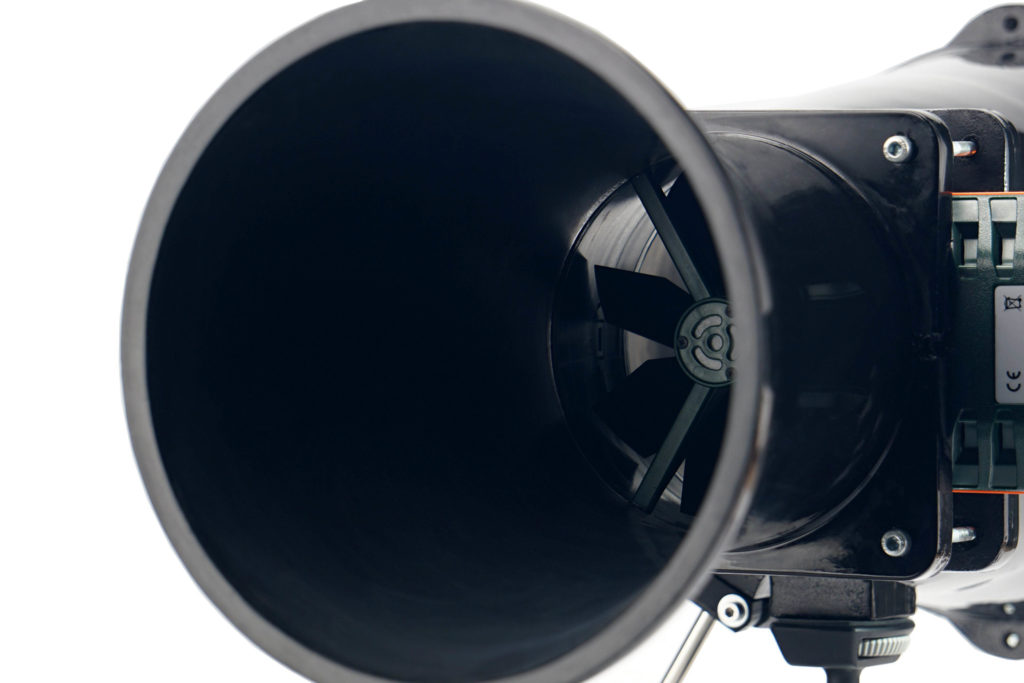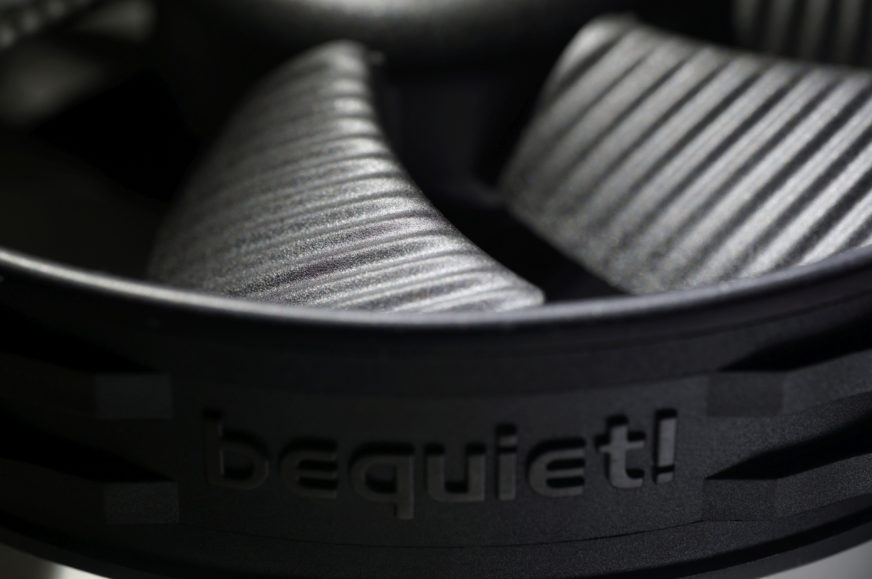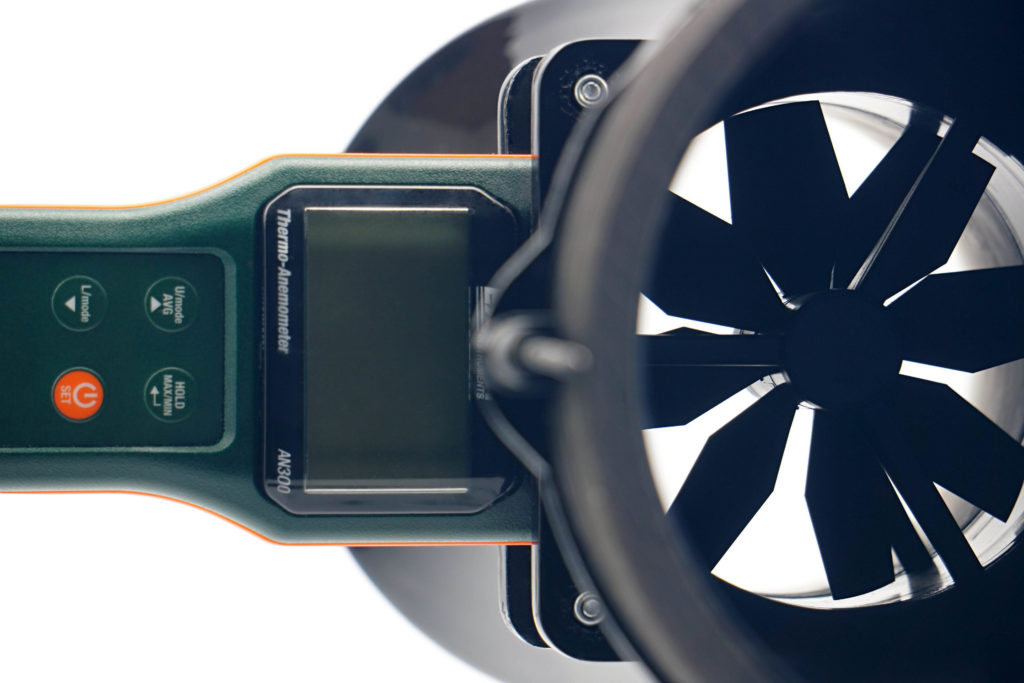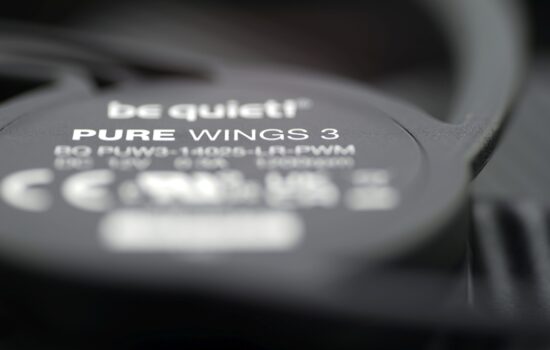… and airflow
With the addition of the Shadow Wings 2 tests, you now have a full overview of the features of all unlit BeQuiet! fans in 120 mm format. Shadow Wings 2 is between Silent Wings 3 and Pure Wings 2 in terms of both price and design. In terms of efficiency, they are closer to the more expensive Silent Wings 3 and in certain situations they give top-notch results. Given the lower price, this can be a very attractive option, but there are some things to look out for.
… and airflow
With airflow measurements, we can well explain why the test tunnel is shaped the way it is. It doesn’t consist of two parts just so that the “exhaust” can be conveniently clogged for pressure measurements. The anemometer (i.e. the wind speed measuring instrument) is held together by two parts, two formations, through the flanges.
The front part, at the beginning of which the fan is mounted, becomes steadily narrower and from about two thirds of the way through the cross-section is smaller than that of a 120 mm fan. The reason for this is that the cross-section of the anemometer is always smaller than that of the fans tested. The taper towards the anemometer fan is as smooth as could be chosen and the tunnel walls are smooth. This has minimized the occurrence of unnatural turbulence.
The difference between the cross section at the intake (fan under test) and at the constriction point (anemometer) also means a difference in dynamic pressure, the principles of the Venturi effect apply here. In order to avoid distortion at this level and to ensure that the fan airflow is not different from what it actually is, the Bernoulli equation must be applied to the measured values (for maximum accuracy, the calculation also takes into account the internal cross-sectional area of the anemometer, i.e. its inactive part ). After all this, it is again possible to confront our results with the paper parameters.
We use an Extech AN300 anemometer with a large 100 mm fan for the measurements. Its big advantage over other anemometers is that it is made for bidirectional sensing. This allows tests at different fan orientations. However, the “pull” position is more suitable or accurate for measurements, even though it may not seem so at first glance, but we’ll explain.
Here, we get to the second part of the tunnel, the part behind the anemometer. It is part of the whole device, mainly to allow a laminar flow of air to arrive at the rotor of the anemometer. Otherwise, uncontrolled side whirls would be reflected in the results, which are inconsistent with accurate measurements. Therefore, we will test the flow in the pull position. If anyone would like us to elaborate more on this topic, we can elaborate further at any time in the discussion below the article. Ask away. 🙂

In connection with the anemometer, we will return a little more to the noise measurements and to the setting of modes according to fixed noise levels. It may have occurred to you as you were reading that the anemometer fan is also a source of sound that needs to be filtered out when testing fans. For this reason, we insert a belay pad between the frame and the anemometer fan before each measurement and mode setting according to the fixed noise level.
- Contents
- BeQuiet! Shadow Wings 2 (BL085) in detail
- The basis of the methodology, the wind tunnel
- Mounting and vibration measurement
- Initial warm-up and speed recording
- Base 6 equal noise levels…
- ... and sound color (frequency characteristic)
- Static pressure measurement…
- … and airflow
- Everything changes with obstacles
- How we measure power draw and motor power
- Measuring the intensity (and power draw) of lighting
- Results: Speed
- Results: Airlow w/o obstacles
- Results: Airflow through a nylon filter
- Results: Airflow through a plastic filter
- Results: Airflow through a hexagonal grille
- Results: Airflow through a thinner radiator
- Results: Airflow through a thicker radiator
- Results: Static pressure w/o obstacles
- Results: Static pressure through a nylon filter
- Results: Static pressure through a plastic filter
- Results: Static pressure through a hexagonal grille
- Results: Static pressure through a thinner radiator
- Results: Static pressure through a thicker radiator
- Results: Static pressure, efficiency by orientation
- Reality vs. specifications
- Results: Frequency response of sound w/o obstacles
- Results: Frequency response of sound with a dust filter
- Results: Frequency response of sound with a hexagonal grille
- Results: Frequency response of sound with a radiator
- Results: Vibration, in total (3D vector length)
- Results: Vibration, X-axis
- Results: Vibration, Y-axis
- Results: Vibration, Z-axis
- Results: Power draw (and motor power)
- Results: Cooling performance per watt, airflow
- Results: Cooling performance per watt, static pressure
- Airflow per euro
- Static pressure per euro
- Results: Lighting – LED luminance and power draw
- Results: LED to motor power draw ratio
- Evaluation













Which Fan would you recommend to use as 3x Intake and Rear Exhaust on the Corsair 4000D between the Shadow Wings 2(BL085), Pure Wings 2(BL039) and Light Wings(BL072)? I’m having a Hard time deciding.
Have you seen our Light Wings (BL072) tests? We published them later than the tests of Shadow Wings 2 (BL085) and Pure Wings 2 (BL039), so their results are missing in the graphs of this article. But you can find them in this one.
The behaviour of all three fans will be very similar in your case, both performance-wise and acoustically. Nevertheless, the Pure Wings 2 is the model that achieves the lowest airflow at equal noise level, but it is also the cheapest… If you are also considering the Light Wings (BL072), I assume you have a higher budget and at the same time we might not care so much about the ARGB LEDs (since you are also deciding between unlighted fans)? In that case I find Shadow Wings 2 (BL085), with which you will not get worse results, the most attractive option. The argument for Light Wings (BL072) could be a wider speed range with lower minimum speeds. Shadow Wings 2 (BL085) start from almost 500 rpm. If you were to run the fans above that anyway, it really doesn’t matter.
I also checked the vibrations, which can, especially in your type of use (on a case), increase the noise, but they are practically zero with the BL085 as well as with the BL072. Personally, I would reach for the Shadow Wings 2 (if you don’t crave the extra low speed of the Light Wings) and enjoy the 40 euros saved. 🙂